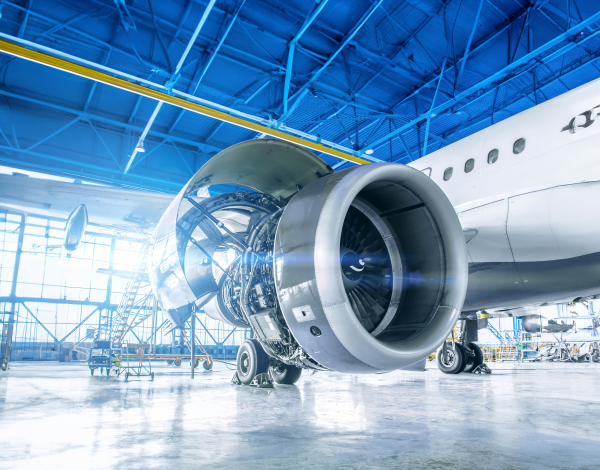Many of the discussions we had at Farnborough International Airshow highlighted common challenges and situations we are seeing across the aerospace sector. These exchanges served to underscore the complexities and opportunities present in today’s market, as well as the pressing need for innovation and collaboration.
We wanted to share our key findings and insights from these discussions, and to shed light on the strategic directions and emerging trends that will shape the industry’s future.
Steady growth in aerospace
Experts predict the civil aerospace sector will grow steadily, with passenger use increasing by 2% year-on-year from now until 2030. An uptick in global air travel demand drives this growth, while economic recovery and the proliferation of new routes, particularly in emerging markets, support it.
As airlines expand their fleets to cater to this increasing demand, there will be a surge in the procurement of new aircraft, fuelling the aerospace industry’s growth.
Challenges for tiered suppliers and OEM production 
Tiered suppliers are facing significant issues keeping up with OEM production ramp-ups.
This challenge is particularly acute as suppliers are already grappling with resource constraints and rising costs. The discussions highlight the need for strategic support and solutions to ensure that suppliers can meet the increasing demands of OEMs, which is critical for the sustained growth and stability of the aerospace sector.
Suppliers face challenges that extend beyond production capacity. Supply chain vulnerability has become a major concern, with global events such as pandemics, geopolitical tensions, and natural disasters exposing the fragility of just-in-time inventory systems. To mitigate these risks, many suppliers are increasing their stock holdings, but this strategy comes at the cost of tying up significant financial resources and valuable storage space.
Cash flow management presents another challenge. The aerospace industry’s long lead times and high upfront investment requirements can strain suppliers’ liquidity, especially smaller and medium-sized enterprises. This financial pressure is exacerbated by the need to invest in new technologies and processes to meet evolving OEM specifications and sustainability requirements.
Addressing these challenges requires a holistic approach that goes beyond simply increasing production capacity. It calls for innovative financing solutions, strategic partnerships with supply chain specialists, and possibly industry-wide collaboration to build more resilient and adaptive supply chains.
The role of resilience
Resilience emerged as a key theme and challenge for the aerospace sector, with discussions centred on the importance of harnessing capabilities to present genuine offerings that stand out in a competitive market.
There is a clear and present need for much greater end to end supply chain visibility and management wherein informed decision making, risk management and investment decisions can drive operational resilience into up and downstream manufacturing processes underpinned by effective and efficient logistics processes. Unipart is able to deliver class-leading, end to end supply chain performance improvements across a currently disaggregated and fragmented supplier-OEM-customer landscape. A comprehensive and collegiate approach will better fortify the industry’s capacity to withstand and recover from disruptions.
Collaboration and resilience
The show also underscored the need for enhanced collaboration between government and industry partners to address emerging threats. These include supply chain fragility and global security issues, which necessitate a cohesive approach to technology sharing, new commercial models, and risk management.
There is a growing recognition of the importance of expanding national manufacturing capabilities to ensure supply chain resilience. This involves not only informed decision-making and comprehensive visibility across the aerospace sector but also a commitment to robust reporting mechanisms.
The discussion extended to the sharing of intellectual property and the adoption of new commercial models that balance shared risks and rewards. Such collaborations are crucial for building on innovation and ensuring the industry can adapt to rapidly changing technological landscapes and geopolitical realities.
Alternative fuel systems and eVTOLs 
A significant trend highlighted at the show was the focus on alternative fuel systems, especially in electric Vertical Take-Off and Landing (eVTOL) aircraft. These very short-haul air taxis represent a burgeoning segment within the industry, promising to revolutionise urban mobility.
The push towards electric propulsion is driven by the need for greener, more sustainable air travel solutions. The industry’s commitment to developing alternative fuel technologies signals a major shift towards reducing carbon footprints and enhancing environmental stewardship.
MRO Trends
Maintenance, Repair, and Overhaul (MRO) services have become a critical focus for many companies within the aerospace sector. The airshow highlighted the increasing demand for MRO services as the global fleet continues to grow and age. This trend is driven by the need to maintain operational readiness and extend the lifespan of existing aircraft, especially in a market where new aircraft production cannot keep pace with demand.
Many industry professionals discussed the evolving requirements of MRO, including the need for advanced diagnostics, predictive maintenance technologies, and the integration of digital solutions. Companies are increasingly investing in these areas to offer more efficient and cost-effective services. Additionally, there is a growing need for sustainability within MRO, with a focus on reducing waste and improving the lifecycle management of components.
The discussions at Farnborough underscored the importance of a robust MRO strategy, not only to meet current demands but also to prepare for future challenges. Lifecycle solutions, as offered at Unipart Logistics, ensure sustainability considerations from cradle to grave are met, including the responsible recovery, repurpose, resale and recycling of materials in line with global regulations, local legislation and our customers sustainability targets.
Generation 6 and unmanned systems
On the defence front, there was a strong emphasis on the development of Generation 6 and unmanned fighter jets, as well as drones. These advancements are crucial as nations seek to enhance their military capabilities amidst a rapidly changing geopolitical landscape.
The emergence of these cutting-edge technologies is closely tied to the strategic responses of OEMs. These systems promise greater flexibility, reduced risk to personnel, and the ability to execute complex missions with high precision.
The need for a more holistic/collaborative approach wherein there is a growing acknowledgment that tiered suppliers need support to drive innovative, resilient and efficient solutions into their logistic processes in order to concentrate on their core output (manufacturing) if they are to keep pace with OEM production demands. Unipart is well-placed to provide end-to-end supply chain support and advice, as well as delivery of world-class logistic services, to OEMs and tiered suppliers.
Sustainability – A mixed priority
Many visitors discussed sustainability, but they focused primarily on technological advancements and market growth opportunities instead.
Whilst the majority of the well-known OEMs have publicly stated their determination to reduce carbon emissions, it is clear that this is not a key priority of some of the smaller / more niche sectors within the industry. Noting that legislation will increasingly drive non-discretionary sustainability targets it is clear that there is a need for broader industry engagement and action. As the world faces mounting environmental challenges, the aerospace sector’s commitment to sustainability will become increasingly critical.
Looking ahead
It is clear that the aerospace industry is facing significant change and evolution. The conversations with our visitors highlighted a range of challenges and opportunities, and for companies and stakeholders within these sectors, the time to act is now.
If you’d like to explore these topics further, whether it’s discussing industry trends, emerging technologies, or strategic collaborations, get in touch with our Director of Aerospace and Defence sectors, Simon Wheelton.
Or, for more information on the services we offer, visit our defence or aerospace websites.
